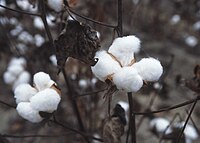
Photo from wikipedia
Abstract Cotton is one of the primary resources in many modern industries and with increasing demand rates the current challenge is to find other sources of cotton production with lower… Click to show full abstract
Abstract Cotton is one of the primary resources in many modern industries and with increasing demand rates the current challenge is to find other sources of cotton production with lower prices and higher quality whereas cotton produced only by agriculture is not sufficient for these needs. This is focused on developing a new strategy to make the textile waste a new sustainable source of recovered cotton to face this shortage. This strategy is summarized as development of a chemical technology using sustainable and commercial chemicals to recover cotton from waste textile. The technology consists of three sequential processes: a) textile dye leaching using Nitric Acid as a pretreatment of the original waste, b) dissolution process using Dimethyl Sulfoxide (DMSO) as the main treatment to dissolve the organic materials from the treated fabric, including polyester and remaining organic part from textile dyes, and c) bleaching process using sodium hypochlorite and diluted hydrochloric acid for final recovered cotton purification. Preliminary experiments were performed at a laboratory scale to determine the optimum conditions on a few grams of two different types of denim fabric. To simulate the pilot scale, the main experimental work was conducted for full-size blue and black waste jeans trousers in a developed reactor with capacity 1 kg based on the preliminary experimental results. To close the lifecycle loop of the suggested strategy, rotary evaporator was used to extract the polymeric part and regenerate the spent DMSO, while the acid was regenerated by activated carbon. Additionally, suggestions on treatment of the water contaminated by acid and solvent (obtained after washing) were given. Morphology, thermal behavior, and chemical structure of the recovered cotton, regenerated acid, solvent, and recovered polyester were investigated. Based on the recycling rate (93%), profitability (1466 $/ tonne), greenhouse gas emissions (-1,534 CO2-eq/ tonne), and sustainability assessment, the developed strategy can be seen as a high-potential approach for recovery of cotton.
Journal Title: Resources, Conservation and Recycling
Year Published: 2019
Link to full text (if available)
Share on Social Media: Sign Up to like & get
recommendations!